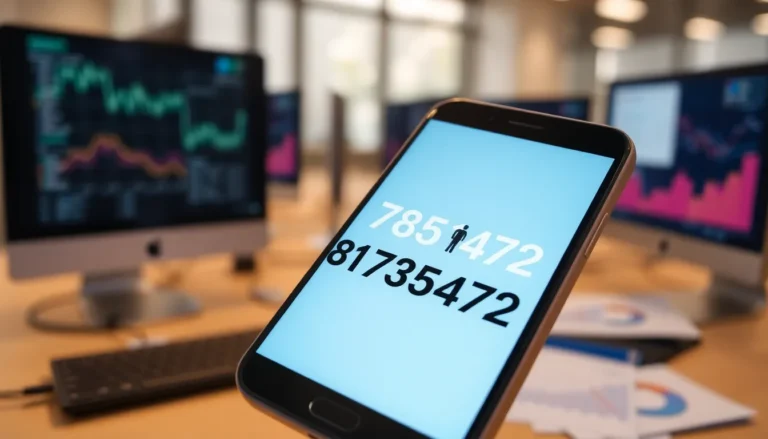In today’s fast-paced world, battery life can make or break the user experience. With smartphones, laptops, and other gadgets becoming essential tools, optimizing battery performance is no longer just a luxury—it’s a necessity. Every user has faced the dreaded low-battery warning, often at the most inconvenient times.
Understanding how to extend battery life not only enhances device longevity but also improves overall efficiency. Simple adjustments and smart habits can lead to significant improvements, allowing users to stay connected longer without the constant worry of finding a charging outlet. This article dives into effective strategies and tips for maximizing battery life, ensuring devices can keep up with the demands of modern life.
Table of Contents
ToggleUnderstanding Battery Life Optimization
Optimizing battery life enhances device longevity and performance. This section details the importance of battery life and the factors that affect battery performance.
Importance of Battery Life
Battery life plays a significant role in user experience. Extended battery life ensures devices remain functional throughout the day, reducing interruptions. Longer battery life enhances user productivity, allowing uninterrupted access to essential applications and services. Effective battery management extends the overall lifespan of devices, preventing premature hardware replacements.
Factors Affecting Battery Performance
Several factors impact battery performance, including:
- Screen Brightness: High brightness levels drain battery quickly.
- Background Apps: Apps running in the background consume power and resources.
- Connectivity: Continuous use of Wi-Fi, Bluetooth, or GPS increases battery usage.
- Age of the Battery: Older batteries tend to hold less charge and deplete faster.
- Temperature: Extreme heat or cold affects overall battery efficiency.
- Power-Hungry Features: Features like live wallpapers and high-resolution video playback can drain battery rapidly.
Understanding these factors helps users implement strategies that positively influence battery life.
Techniques for Battery Life Optimization

Optimizing battery life involves various techniques, focusing on both software management and hardware adjustments. The following sections detail effective strategies to enhance battery performance.
Software Management
- Update Software Regularly: Updating to the latest software version can improve battery efficiency through optimizations and bug fixes.
- Limit Background Processes: Closing unused applications running in the background prevents power drain.
- Adjust Location Services: Using location services only when needed saves battery by reducing GPS usage.
- Disable Unnecessary Notifications: Turning off notifications from less important apps minimizes screen wake-ups and power consumption.
- Utilize Battery Saver Mode: Activating battery saver mode reduces performance to extend battery life, especially during critical times.
Hardware Adjustments
- Reduce Screen Brightness: Lowering brightness settings significantly decreases battery use, especially in brightly lit environments.
- Disable Connectivity Features: Turning off Wi-Fi, Bluetooth, and mobile data when not in use conserves battery life.
- Limit Use of Live Wallpapers: Opting for static wallpapers instead of live ones reduces processor workload.
- Maintain Optimal Operating Temperature: Keeping devices between 32°F and 95°F (0°C and 35°C) helps batteries perform efficiently.
- Replace Old Batteries: Swapping aging batteries with new ones improves overall device performance and battery life.
Implementing these techniques focuses on maximizing battery longevity and ensuring devices remain functional throughout daily use.
Best Practices for Users
Optimizing battery life requires consistent practices and adjustments. Users can implement several strategies to boost their devices’ efficiency and longevity.
Regular Maintenance Tips
- Clean charging ports: Dust and debris can hinder charging efficiency. Regularly inspect and clean charging ports to maintain optimal connection.
- Update apps and software: Developers release updates that optimize performance and fix bugs, potentially improving battery efficiency. Keep apps and operating systems current.
- Monitor battery health: Use built-in battery health tools to assess battery performance. Replace batteries that show significant wear to ensure reliable usage.
- Reduce app clutter: Uninstall unused applications that run background processes, thereby conserving battery power and freeing up storage.
Settings to Optimize Battery Life
- Lower screen brightness: Adjust screen brightness to 20-30% of maximum. Manual adjustment or automatic settings can significantly extend battery life.
- Enable battery saver mode: Activate battery saver mode, which adjusts system settings to minimize power consumption, extending battery life during critical times.
- Limit background data: Restrict background data for apps that don’t need it. This prevents excessive battery drain from ongoing updates and notifications.
- Turn off location services: Disable location services for non-essential applications. This reduces constant GPS usage, which drains battery quickly.
- Manage connectivity: Turn off Wi-Fi, Bluetooth, or mobile data when not in use. Disconnecting these features eliminates background scanning and saves energy.
Future Trends in Battery Life Optimization
Battery life optimization continuously evolves with innovations aiming to enhance performance and sustainability.
Emerging Technologies
Emerging technologies play a significant role in improving battery life. Solid-state batteries, which utilize solid electrolytes, promise higher energy density and safety compared to conventional lithium-ion batteries. These batteries can last longer and charge faster, drastically reducing downtime. Another noteworthy advancement is the adoption of lithium-sulfur batteries, which offer potentially five times the capacity of traditional lithium-ion counterparts. Nanotechnology also contributes by improving battery materials, enhancing charge cycles, and reducing degradation rates. In addition, artificial intelligence (AI) algorithms are being integrated into battery management systems to optimize charging patterns and usage, thus extending overall battery lifespan.
Sustainable Practices
Sustainable practices in battery life optimization focus on reducing environmental impact. Manufacturers are increasingly using recyclable materials for battery production, minimizing waste throughout the life cycle. Additionally, practices such as energy harvesting involve capturing energy from the environment, converting it into usable power for devices, and prolonging battery life. Companies are also investing in second-life applications for used batteries, allowing them to serve alternative functions, like energy storage in renewable systems. Implementing these sustainable practices not only enhances battery longevity but also contributes to a greener technology landscape.
Optimizing battery life is essential for maximizing the performance and longevity of devices. By understanding the factors that affect battery health and implementing effective strategies, users can significantly enhance their device experience. Regular maintenance and smart management of settings not only prolong battery life but also reduce the need for frequent recharges.
As technology continues to advance, staying informed about emerging trends and innovations in battery optimization will empower users to make the most of their devices. Embracing these practices ensures that users remain connected and productive without the constant worry of low battery alerts.



